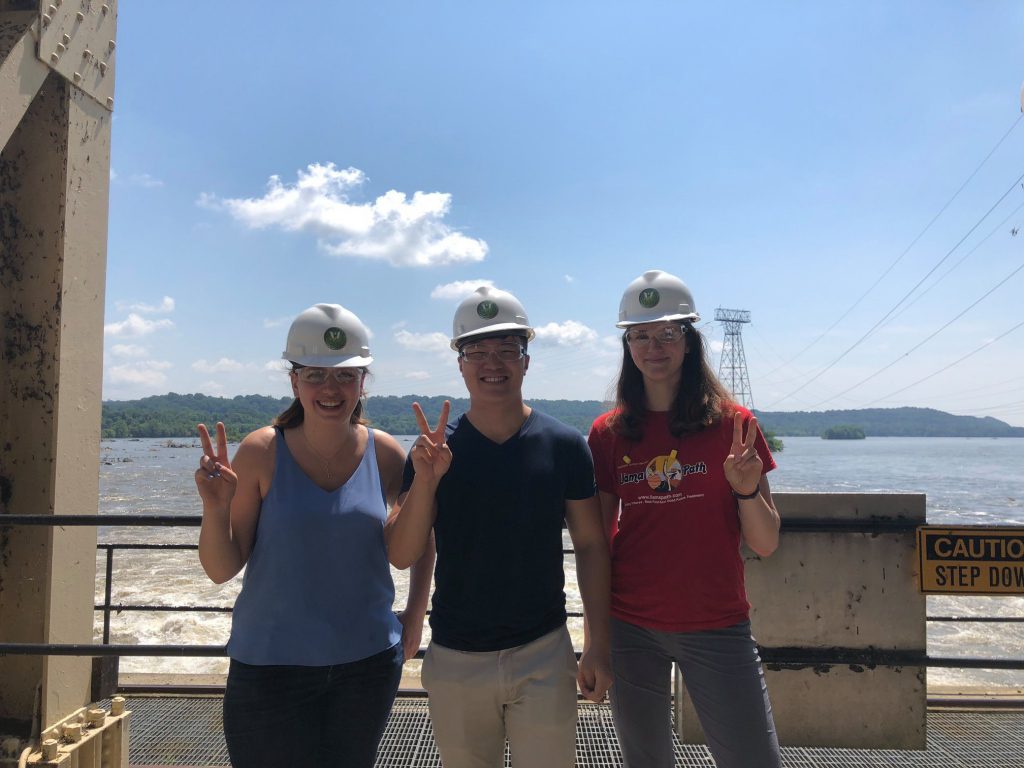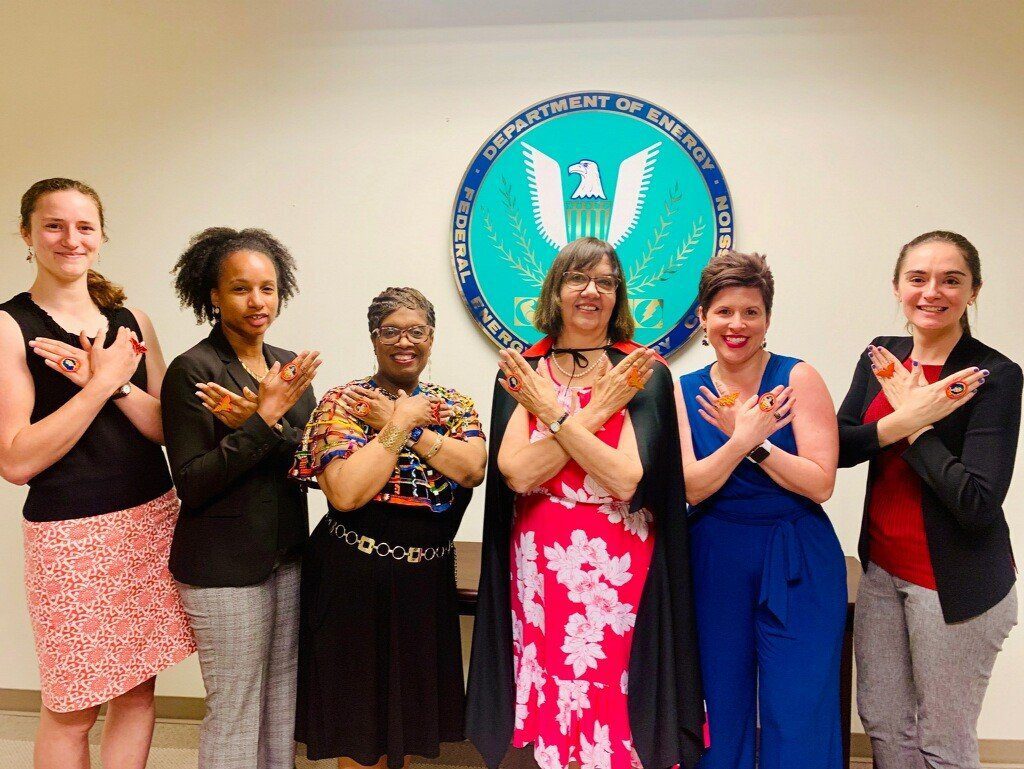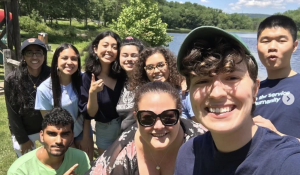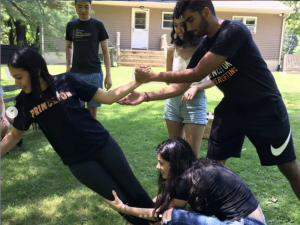This summer, I worked in a mechanical engineering lab at Princeton. There, I contributed to a project headed by a postdoc studying the diffusion of fluids and nutrients through soil and how this impacts the bacteria living in clay soils. These bacteria take carbon dioxide out of the atmosphere, but their behavior in specific soil conditions is difficult to determine, which relates my project to climate change and sustainability.
Something I found that I really liked this summer was working on a project that has environmental significance. I am interested in sustainability and environmental issues – I am part of the sustainability and resilience cohort, after all – but as a chemical engineering student it isn’t something that I am sure will be part of my career. However, I this summer I worked in a mechanical engineering lab on a project that related to the environment, which just showed me that there is environmental significance in so many different areas. I enjoyed knowing that the work I did had this significance, and I will move on from this experience knowing even more that my passion for the environment and for what I’m studying can be intertwined.
This summer I also discovered is that working in an academic lab might not be something that interests me after Princeton. I enjoyed having the freedom to explore an area of study and take my experiments in the direction I felt was best. For example, I often studied the movement of nutrients through wet or dry artificial clay soils, and depending on what I saw I could decide my next move – whether to repeat an experiment, change a piece of it, or move in an entirely different direction. While I enjoyed this for the summer, I don’t think I could see myself working in this mindset for an extended period of time. Instead of having to wait years to see the results of my study, I think I would prefer to work on shorter term projects, where I can see the results of what I do more quickly.
Overall, I am so thankful for this experience. Thanks to this project and those working with and around me, I learned so much about fluid mechanics, soil properties, cameras, and academic labs in general – all things I previously knew next to nothing about. But more importantly, I learned more about myself and what my future might look like.

My last day at FERC on August 9. Because I’d already packed all of my business casual clothing to go home, I had to wear in my EWB Peru T-shirt, which resulted in a nice juxtaposition of the two experiences I had this summer.
After wrapping up my 10-week PICS internship at the Federal Energy Regulatory Commission (FERC) on August 9 (see my previous post about my experience there), I had a quick 36-hour turnaround, filled with frantic packing, before I boarded my flight from Washington, DC, to Lima, Peru. Thus began the second chapter of summer 2019 for me — a four-week trip to Otuzco (a city of about 25,000 people in the highlands of northwestern Peru) to build a potable water delivery system for the rural community called Pusunchás.
It all started back in September of my freshman year. I knew that I wanted to join a service organization on campus whose mission reflected my interests in sustainable community development. After thoroughly exploring the fall activities fair, I found Princeton’s Engineers Without Borders (EWB) chapter, which is part of the national EWB-USA nonprofit and the international EWB network. Similar to Doctors Without Borders (a more well-known initiative), EWB partners engineering students and professionals with developing communities in need of infrastructural improvements (e.g., water supply, electricity sources, clean cook stoves, etc.). Here at Princeton, EWB has projects running in three different countries: Peru, Dominican Republic, and Kenya. Each group has its own culture, reflective of the nature of the communities with which they work, and after researching all three, I decided to join the Peru team (partially because I am very fond of hiking in mountainous terrain, as you can see in the photo below).

A panorama view of the mountains I took one day after our work had ended.
After joining the Peru team in September, I quickly became more involved, co-leading our finance sub-team to successfully raise the $11,000+ for our work abroad this year. Our current project, started in 2015 and based in Pusunchás (which won’t show up on Google Maps but is about a 30 minute drive uphill from Otuzco where we are staying), will deliver drinking water to 121 households by the end of this year. Throughout the school year, we spend time designing the project (this is where our engineering knowledge comes in handy) before seven of the team members (one of them this year being me!) travel to Pusunchás over the summer to oversee the construction of the system. We purposefully schedule the trip for mid-August to allow all of our team members to fit in internships beforehand. Some of the other Princeton students traveling with me worked on campus prior to this trip doing research, for instance, while others worked at engineering firms or even traveled abroad to other countries.
Living in Otuzco has definitely been really eye-opening for me. This is my first time in what could arguably be called a “developing” nation (recognizing how problematic this term is), and I’ve already learned so much just by looking and listening. Stray dogs roam the streets but are never really aggressive (many of them are actually quite cute). Most houses are made out of dirt/adobe bricks, and roofs are adorned with colorful lines of laundry and with livestock coops (guinea pigs, or cuy, are a popular source of protein here, in addition to the ubiquitous chickens/roosters who wake me up way too early). A lot of locals drive these vehicles called mototaxis, which are like three-wheeled motorcycles with colorful carts attached to carry passengers. There aren’t any stop signs, and there is only one traffic light in town that is rarely obeyed. Our group is staying in dormitories at El Centro de Formación de Pastoral Rural, which is an outreach center run by Las Marianistas, a Catholic missionary nonprofit who has been our team’s in-country partner/sponsor for several years now. We are blessed to have hot water in the showers (which is heated by solar tubes on the roof), although we have to hand wash our laundry (I can’t believe my great-grandma did this back in the day, but a funny sustainability side note is that line-dry laundry is making a comeback in the US because of its decreased energy use as compared to conventional dryers — and the Sun is still a highly effective drying tool, as I’ve realized from the many sunburns I’ve gotten despite the layers upon layers of sunscreen I’ve put on).

Our rooftop solar water heater.

Laundry lines on our rooftop deck/laundry area.
Every day (except for Sundays, a much-needed day of rest), we travel from Otuzco to Pusunchás in the pickup truck of our in-country mentor, Julio Avalos, who works for Las Marianistas. Julio is absolutely critical to the success of our project because he knows how to navigate the very, very rough roads of rural Peru like a pro (there have been several times when I’ve wondered whether what we are driving on is a road or just a slab of bedrock). Julio also used to work for Ingenieros Sin Fronteras, the Spanish version of EWB, so he has a lot of important technical knowledge, which has led him to advise other EWB projects in the area, including one run by Temple University. Another crucial component of our work in the community is the Junta Administrative de Servicios Sanitarios (JASS), a group of about 10 Pusunchás residents who oversee the governance of the water delivery system and manage local disputes. While we control the system design, we rely on the JASS to coordinate which residents will work with us on which days to help with construction (pickaxing sheer bedrock is really difficult, as one might imagine, so having the help of locals who work on farms each day and are thus incredibly strong and used to physical labor is super beneficial). The JASS also coordinates our daily lunches, which are provided by a different household each day (typically chicken, rice, and the ubiquitous Peruvian potato… and some lentils/salad/carrots if we get lucky).

Me taking a flow rate measurement at a tapstand at one of the households in Pusunchás. I definitely look a little weird in my hiking/sun protection gear.
If Otuzco is a new urban environment for me, however, Pusunchás is a new rural environment. The community is spread out over dozens of square miles, meaning we are typically hiking several miles each day on steeply sloping terrain (our iPhones have told us that we’ve done 100+ flights of stairs on several days). Houses are made out of adobe bricks and are completely open to the environment (the temperature here is very mild with low humidity and few biting insects, so this isn’t really an issue). Livestock are everywhere and just seem to roam free — chickens, cows, pigs, turkeys, donkeys, horses, and lots of dogs of varying ages (there have been a lot of many cute puppies). Slopes are divided into chacras, or plots of land dedicated to a particular crop (wheat, potatoes, carrots, corn, cabbage, and many others), although there really aren’t fences here; people just seem to know whose chacra is whose.
We’re about halfway into the trip thus far, and already I’ve found it hugely educational. My conversational Spanish (which I picked up in high school classes) has improved significantly through the daily interactions we have with community members. In our spare time, while we haven’t gotten to explore any of the “famous” sites Peru is known for (Machu Picchu is on the other side of the country, for instance, so that will have to wait for another time), we have found a lot to do in Otuzco, eaten several different delicious local dishes (my favorite is lomo saltado, which is a mix of steak with potato slices, onions, and tomatoes in a savory sauce), and spent time cooking together as a group (last Sunday was filled with fresh fruit smoothies, veggie soup, and omelettes, called tortillas here).
What I’ve also found fascinating is how Otuzco/Pusunchás are from a sustainability standpoint. Some practices here are certainly more sustainable than what we do in the U.S. The majority of the food is produced locally. Laundry is done by hand and line-dried, using significantly less energy. 100% of the electricity comes from local hydropower fueled by glacial ice melt, according to Julio. On the other hand, some practices are visibly worse than in the U.S. Garbage disposal is pretty poor here, with trash lining the streets and gullies; plastic bags and packaging are ubiquitous, although the local grocery store does charge a fee for plastic bags (this is the only place that does this, however — local merchants/stalls can get away with not charging). What’s worse is that there doesn’t seem to be too much awareness about the litter problem. Single-use consumerism is progressing as it always has in other countries. The tap water system in Otuzco is also not super clean (we treat it with bleach before we drink it), and while rural areas like Pusunchás have electricity, many of these utilities are provided as a result of local government initiatives that are basically publicity stunts (i.e., building out infrastructure is seen as more of a photo opportunity for the administration instead of a provision of basic necessities). As a result, while Pusunchás had a water system several years ago which was built out by the government, it has since fallen into disrepair, and the government has failed to fix it, which is why we are building our project now. Interestingly enough, during the mayoral election for Otuzco last year (campaign signs are still left painted onto many houses around the city), candidates reached out to our group to see if they could “partner” with us, but this was apparently only their way of trying to use our EWB project to make themselves look good.

Trash piled up in the streets. At times, these heaps would be set on flames and left to burn.
Another controversial theme I’ve been reflecting on during my time here has been one of tokenism. I initially began discussing this a couple of months ago with our cohort’s student advisor and Service Focus graduate, Kate Schassler ’21. What has proven to be problematic with many international humanitarian efforts is that wealthier people from developed nations (typically majority white) have used volunteer projects in developing nations to boost their own appearances/self-worth under the premise that they are helping the “poor, starving peoples of the Third World” (who are often people of color). This results in a toxic (and sometimes racially awkward) relationship in which the beneficiaries of the project are reduced to mere photography subjects.
Going into this EWB trip, I made sure to be particularly aware for any signs of tokenism. Luckily, I’ve found that for the most part, our relationship with Pusunchás is cordial and fairly egalitarian. The community members respect us for our technical engineering knowledge, but we let them (specifically the JASS) handle interpersonal dynamics. All of us on the travel team put forth our best efforts to learn and to speak Spanish, which allows us to communicate pretty fluidly without the need for a translator. Any photos we take of community members are typically requested by them, although this isn’t always the case (the problem with photography is that conventional donors who support EWB are conditioned to see heartstring-tugging photos of community members and their kids receiving clean water, so it’s tough for us to both satisfy American publicity standards for international humanitarian work and to respect the personal boundaries of community members). Some other members of the travel team and I are working to ensure that our summer blog posts on the EWB website and other publicity materials moving forward do not contain overtly tokenistic messaging or photos.
All in all, I’ve been immensely enjoying my time here thus far, have gotten to bond with the six other Princeton students on my travel team, and have loved the time we spend outdoors every day, both working and relaxing. I’m an avid bird-watcher, so I’ve gotten to see many new species in my spare time (many people have asked me what my binoculars are for, though). While my experience in Otuzco/Pusunchás is completely different from the 10 weeks I spent interning at FERC in DC, I think that these two adventures complement each other nicely. Here in Peru, I’m putting my engineering knowledge to use in the field; in DC, I used my engineering knowledge to read and write about energy policy. Moreover, sustainability has been woven through all 14 weeks of my summer, and I’m incredibly excited to discuss what I’ve learned with my fellow Sustainability & Resilience cohort members this coming year. Thank you to the Pace Center and the Service Focus program for helping to fund my journey to Peru.

Part of our travel team tries emoliente, which is a local herbal beverage that tastes like liquefied bubble tea pearls — a great pick-me-up after dinner for cold nights! From left to right: Sydney Hsu ’21, Kristen Ahner ’22, me, Riley Wagner ’20, Josh Umansky Castro ’17 (an EWB Princeton alumnus who is serving as a mentor for us this summer), and Pranav Iyer ’22.
By Claire Wayner

I and the two other PICS interns at FERC, Lizzie Parker and TJ Li, touring the Conowingo Dam in Maryland on a FERC intern field trip.
This summer, I’ve been working in the Office of Commissioner Cheryl LaFleur ’75 at the Federal Energy Regulatory Commission in Washington, D.C. through a PICS internship. You may think that the Federal Energy Regulatory Commission, or “FERC” as we affectionately call it, sounds really important, but you most likely also have no clue what FERC actually does (I’m actually still trying to answer this one). Think of us as an independent, bipartisan (ha) group of 1,100 energy nerds who spend all day regulating the utilities that provide America’s electricity. When you turn on the lights or the A/C, you can bet that FERC had something to do with determining where the power came from and how the infrastructure to deliver the electricity was built out.
In my specific role in Commissioner LaFleur’s office, I am working on a lot of energy and environmental policy and economics, helping our office’s three legal advisors and one technical advisor to decide how Cheryl will vote on each order which comes before us. While FERC staff can approve or deny some proposals that come before us (e.g., local utility changes its rates), most major proposals are voted on by FERC’s commissioners, of which there are currently four (there are supposed to be five, but the President hasn’t gotten around to nominating a fifth yet, which isn’t that uncommon). About half of our orders deal with changes to the electricity grid and markets (rates, tariffs, etc.), but we also approve infrastructure projects such as natural gas pipelines, liquid natural gas (LNG) export terminals, and hydroelectric dams. This latter category is what I’ve been specializing in during my work at FERC.
On a typical day, I’ll usually be digging into an environmental impact statement (EIS) for a particular project. These documents are prepared by FERC staff to summarize the effects that a project will have on the local environment — anything from removal of vegetation and loss of wetlands to water and air pollution. After I read through these, I talk about the case with Cheryl’s infrastructure legal advisor (and my direct supervisor), Cat Giljohann. We then write up a concurrence (if Cheryl supports it) or a dissent (if Cheryl doesn’t support it). One of the biggest issues we’ve been grappling with currently is the climate impact of fossil fuel projects and how FERC (in our opinion) isn’t doing enough to prescribe adequate mitigation for greenhouse gas emissions. To that effect, I’m preparing a final paper on the Social Cost of Carbon, a carbon emissions pricing tool that FERC could use to require project applicants to offset their climate impacts.
In addition to the day-to-day, working at FERC has been a really incredible opportunity for me to learn about the challenges facing our electric grid in the coming years, especially as we introduce more renewables into the energy mix. I recently finished reading a book, Superpower: One Man’s Quest to Transform American Energy by Russell Gold, all about a renewable energy entrepreneur’s efforts to transform America’s power grid into a national, unified network (instead of the fragmented hodgepodge of regional lines we have now). I’m newly fascinated with the electric grid and am looking forward to taking more energy courses during my time at Princeton. I’ve also gotten to meet fellow interns from all walks of life, go on trips to places like the Conowingo Hydroelectric Plant (which is close to my house in Baltimore, Maryland!), and make lasting relationships with Princeton alumni who currently work at FERC (thank you, Tigernet!). I can’t believe that I have only two weeks left in my internship before I head out to Peru with Princeton’s Engineers Without Borders to build a water delivery system for the rural community of Pusunchas. Thank you to Service Focus for providing this opportunity, and I’m eager to bring back what I’ve learned to my cohort this fall!

This is everyone currently in my office this summer (I’m on the far left). Our office has gone through some staffing changes because Cheryl is stepping down at the end of August, and it just so happens that last week we became an all-female office. Cat (my direct supervisor, second from right) bought us all Wonder Woman rings to commemorate the occasion, and we took this group photo.
By Ritvik Agnihotri
Everyone’s freshman orientation experience serves a crucial role in shaping their outlook on Princeton. As a Community Action Fellow, I am responsible for organizing the Community Action Orientation experience at the Poconos Environmental Education Center (PEEC) for this year. This includes curating the service projects the first-years will spend their time on, communicating with partners about lodging, dining, and activities, and handling the many logistical aspects that are involved with the trip.
There are 7 Community Action Fellows (3 of whom are in Service Focus) and we all work in the Pace Center in Frist (or the women’s center because the couches in Pace are uncomfortable!). We occasionally have field trip days as well; as a collective, we have visited the Grounds for Sculpture and took a wonderful tour of Princeton’s Campus where we learned more about the African American history behind the foundations of our University. We have also taken a two-day retreat in the Princeton-Blairstown Center which was a fruitful experience filled with team-bonding activities and lessons on humility and leadership.
Sara Gruppo and Maggie Hussar are in charge of the Community Action Fellows. They have taught all of us much about leadership, cultural humility, and organization. They are wonderful role models and I am grateful to be able to work under their supervision.
So far, I am loving my Fellowship here. I have gained experience which I am sure I could not have obtained anywhere else, and have also learned about our campus. I can’t wait for the actual Community Action trip!

All of the CA Fellows with Sara and Maggie on our Retreat

An attempt to grab an object without being near it as a team-building exercise on the retreat














